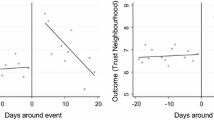Abstract
In November 2001, a nationally representative sample of Americans (N = 973, ages 13–88), queried via WebTVs at home, judged the probability of five terror-related events (e.g., being injured in an attack) and three “routine” risks (e.g., being a victim of other violent crime), in the following 12 months. Judgments of terror risks, but not routine risks, were related to whether respondents were within 100 mi of the World Trade Center. This relationship was found only in the following demographic groups, and not their complements: men, adults, whites, and Republicans. These differential responses to risk have both theoretical and policy implications.
Similar content being viewed by others
References
Archer, John. (1999). The Nature of Grief: The Evolution and Psychology of Reactions to Loss. New York: Routledge.
Baumeister, Roy F. and L. Sommer, Kristin. (1997). "What do Men Want? Gender Differences and Two Spheres of Belongingness: Comment on Cross and Madson," Psychological Bulletin 122(1), 38–44.
Blocker, Thelma J. and Deborah L, Eckberg. (1989). "Environmental Issues asWomen's Issues: General Concerns and Local Hazards," Social Science Quarterly 70, 586–593.
Bruine de Bruin, Wändi et al. (2000)Expressing Epistemic Uncertainty: It's a Fifty-Fifty Chance," Organizational Behavior and Human Decision Processes 81, 115–131.
Bruine de Bruin, Wändi et al. (2000)"What Number is ‘Fifty-Fifty’?: Distributing Excessive 50% Responses in Elicited Probabilities,” Risk Analysis. 22, 713–723.
Cross, Susan E. and Madson, Laura. (1997). “Models of the Self. Self-Construals and Gender,” Psychological Bulletin 122(1), 5–37.
Davis, Patricia. (2002, October 12). “Experts SuggestWays toAvoid Being Target,” TheWashington Post, pp. A18.
Denis, Michael J. (2001). “Are Internet Panels Creating Professional Respondents?” Marketing Research Summer: pp. 34–38.
Fischhoff, Baruch. (2002). "Assessing and Communicating the Risks of Terrorism," In Albert H. Teich, Stephen D. Nelson, and Stephen J. Lita(eds.), Science and Technology in a Vulnerable World. Washington, DC: AAAS, pp. 51–64.
Fischhoff, Baruch, Ann Bostrom, and Marilyn J. Quadrel. (2002). "Risk Perception and Communication," In Roger Detels, James McEwen, Robert Beaglehole, and Heizo Tanaka (eds.), Oxford Textbook of Public Health. London: Oxford University Press, pp. 1105–1123.
Fischhoff, Baruch and Wändi Bruine de Bruin. (1999). “Fifty/fifty = 50?” Journal of Behavioral Decision Making 12, 149–163.
Fischhoff, Baruch et al. (2000). "Teen Expectations for Significant Life Events," Public Opinion Quarterly 64, 189–205.
Gabriel, Shira and Wendi L. Gardner. (1999). "Are There 'His' and 'Hers' Types of Interdependence? The Implications for Gender Differences in Collective versus Relational Interdependence for Affect, Behavior and Cognition,"Journal of Personality and Social Psychology 77(3), 642–655.
Gettleman, Jeffrey. (2002, October 25). "A Frenzy of SpeculationWasWide of the Mark," New York Times, p. A29
Halpern-Felsher, Bonnie L. and Susan G. Millstein. (2002). "The Effects of Terrorism on Teens' Perception of Dying: The New World is Riskier than Ever," Journal of Adolescent Health 30(5) 308–311.
Johnson, Eric. J. and Amos Tversky. (1983). "Affect, Generalization, and the Perception of Risk,"Journal of Personality and Social Psychology 45, 20–31.
Krotki, Karol and J. Michael Dennis. (2001, August). "Probability-based Survey Research on the Internet,"Paper Presented at the 53rd Conference of the International Statistical Institute, Seoul, Korea.
Lerner, Jennifer S. et al. (2003). "Emotion and Perceived Risks of Terrorism: A National Field Experiment," Psychological Science 14, 144–150.
Lerner, Jennifer S. and Dacher Keltner. (2001). "Fear, Anger, and Risk,"Journal of Personality and Social Psychology 81(1), 146–159.
Loewenstein, George F. et al. (2001). "Risk as Feelings," Psychological Bulletin 127, 267–286.
Millstein, Susan G. and Bonnie L. Halpern-Felsher. (2002). "Perceptions of Risk and Vulnerability,"Journal of Adolescent Health 31, 10–27.
Mirowsky, John. (1995). "Age and the Sense of Control," Social Psychology Quarterly 58, 31–43.
Quadrel, Marilyn J., Baruch Fischhoff, and Wendy Davis. (1993). "Adolescent (In)vulnerability," American Psychologist 48, 102–116.
Ross, Catherine E. and John Mirowsky. (2002). "Age and the Gender Gap in the Sense of Personal Control,"Social Psychology Quarterly 65(2), 125–145.
Schlenger, William E. et al. (2002). "Americans' Reactions to Terrorist Attacks," Journal of the American Medical Association 288, 581–588.
Schuster, Mark A. et al. (2001). "A National Survey of Stress Reactions after the September 11, 2001 Terrorist Attacks," The New England Journal of Medicine 345(20), 1507–1512.
Shaw, Benjamin A. and Neal Krause. (2001). "Exploring Race Variations in Aging and Personal Control,"Journal of Gerontology Series B-Psychology Sciences & Social Sciences 56B(2), S119–S124.
Shuchter, Stephen R. and Sidney Zisook. (1993). "The Course of Normal Grief," In Margaret S. Stroebe, Wolfgang Stroebe, and Robert O. Hansson(eds.), Handbook of Bereavement. New York: Cambridge University Press, pp. 23–43.
Slovic, Paul. (ed.). (2001). The Perception of Risk. Thousand Oaks, CA: Sage Publications.
Tversky, Amos and Daniel Kahneman. (1973). "Availability: A Heuristic for Judging Frequency and Probability,"Cognitive Psychology 5(2), 207–232.
Tversky, Amos and Daniel Kahneman. (1973)."On the Psychology of Prediction,"Psychological Review 80(4), 237–251.
Tversky, Amos and Daniel Kahneman. (1974)."Judgment under Uncertainty: Heuristics and Biases,"Science 185, 1124–1130.
Vaughan, Elaine. (1993). "Individual and Cultural Differences in Adaptation to Environmental Risks," American Psychologist 48, 673–680.
Viscusi, W. Kip and Richard J. Zeckhauser. (2003)."Sacrificing Civil Liberties to Reduce Terrorism Risks,"Journal of Risk and Uncertainty 26(2/3), 99–120.
Weinstein, Neil D. (2000)."Perceived Probability, Perceived Severity, and Health-Protective Behavior,"Health Psychology 19(1), 65–74.
Weinstein, Neil D. (1980)."Unrealistic Optimism About Future Life Events,"Journal of Personality and Social Psychology 39(5), 806–820.
Author information
Authors and Affiliations
Rights and permissions
About this article
Cite this article
Fischhoff, B., Gonzalez, R.M., Small, D.A. et al. Judged Terror Risk and Proximity to the World Trade Center. Journal of Risk and Uncertainty 26, 137–151 (2003). https://doi.org/10.1023/A:1024163023174
Issue Date:
DOI: https://doi.org/10.1023/A:1024163023174




